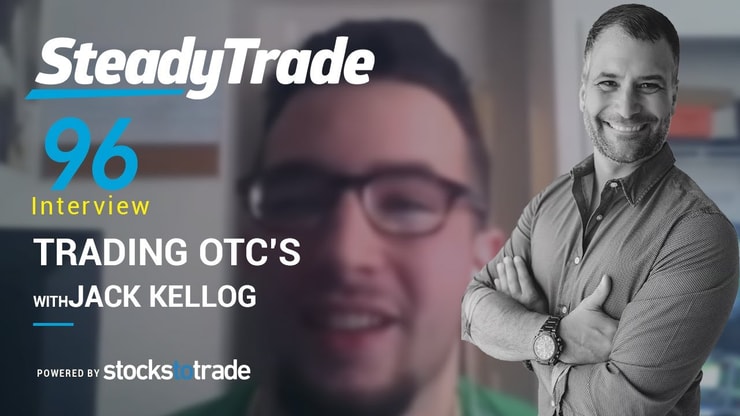Pay attention! Get ready to get inspired. Be prepared to double down on your studies and shift your mindset. Learn from Trading Challenge student Jack Kellogg. He has a great attitude, a strong work ethic, and only the beginning of what I expect will be years of success.
Table of Contents
- 1 Jackaroo’s Success Mindset
- 2 Why Jackaroo Networks With Trading Challenge Students
- 3 Bonus Content: Trading Challenge Q&A with Jack Kellogg
- 4 Congratulations, Jackaroo!
(Bonus Content: Read to the end of this post for free access to Q&A with Jack Kellogg. During this 2-hour Trading Challenge webinar, Jack answers questions from other students.)
I know I’ve mentioned Jack a few times — he goes by Jackaroo over on Profitly. There’s a reason I keep talking about him. Yes, his profit chart on Profitly is impressive — but it runs deeper than that.
Jackaroo started the Trading Challenge back in January 2017. He opened a Thinkorswim account and a small E*Trade account for short-selling. He had the sense after a few small losses to realize he didn’t know what he was doing. He didn’t want to trade his account to zero so he didn’t trade much.
Jackaroo soaked everything up like a sponge. He started paper trading. And he admits he was doing so without a very clear strategy. But he was studying like mad. He was building his knowledge account.
Determined to get over the PDT level and give himself time to learn, Jack kept his valet job. This allowed him to save money. Neither trading account went anywhere his first year. By the end of 2017, he reports he was down roughly $1,000.

Did you catch the part about keeping his job? This is admirable. If you need a job, you need a job! And if you need to earn money to join the Trading Challenge or purchase a DVD then do it. If you’re trying to fund your trading account you might need a second job. Whatever it takes. Do it!
When he finally started trading, Jack was the classic newbie short-seller. He had some wins. He made some good trades and he had the right idea. But he didn’t have control over his emotions as a trader. He gave back all his wins on one messy play with Turtle Beach (NASDAQ: HEAR) in May, 2018.
I have to commend Jackaroo for getting out strategically. He reached out to top student Tim Grittani while still in the trade for advice about how to get out. By doing so, he reports that he was able to reduce his loss by more than 40%**. Still, it was a tough loss and a lesson learned.

By the way, that says a lot about Tim Grittani and the Trading Challenge community as a whole. This is why I love my students so much.
Jack admits the Turtle Beach trade was a disaster. He added to his position outside his risk. He got stubborn and made one classic mistake after another. The scary thing is, he knew what was happening. He knew about short squeezes and where things were going against him.
It’s important to note that Jack recovered psychologically from that loss. In a BIG way. It would have been easy for him to walk away at that point. Instead, he decided he wasn’t ready to short-sell. By defining his boundaries he was able to get back on the path. He decided to get back to his bread and butter plays and stick to his trading plan.
Jack laid it all out in a cathartic admission of his mistakes — a video lesson on Profitly. Not many people are willing to share their worst trade in great detail. Let alone the painful admission they knew better but failed to act. This is important.
Jackaroo’s Success Mindset
There are a few ultra-important things I want you to learn from Jack. Let’s start with his beliefs and mindset when he started the Trading Challenge.
Jack started working as a valet at the age of 16. He worked hard and saved his money. By the time he joined Trading Challenge he knew that money equals freedom. He also knew he didn’t want to go to college.
Actually, Jack didn’t even consider college an option. He says he got Cs and Ds in high-school. He excelled at sports and video games. Not exactly what colleges are looking for unless you’re an NCAA prospect. Ironically, Jack reports that he’s now making more than most of his friends who attended college.
Jack’s story is pretty amazing when you think about it.
We live in a world where college is pushed on high-school students as if it’s the be-all and end-all. They’re encouraged to make ends meet instead of get free. There’s nothing wrong with a job if you need one.
And you need to keep your job if you’re not a self-sufficient trader yet. So don’t take this the wrong way. Here it is…
…having a job sucks. Unless it’s your dream job. That’s cool.
But what if you’re in a job you hate with no vision of something better?
It’s a dangerous trick our mind and society plays on us. We’re not taught a success mindset unless we seek it. Jack has a success mindset. He might not even realize how powerful this is for other traders. Check it out…
Success Mindset Tip #1: Money Equals Freedom
Jackaroo knew — deep down — that money equals freedom. He also knew he could learn a system to take the money he’d saved and create greater wealth with it.
Jack determined at a young age that he wanted money for freedom. He figured out that college isn’t right for everyone. More importantly, it wasn’t right for him. He decided to save enough money to make his money work for him.
His New Year’s resolution in 2017 was to ‘get invested.’ He started looking for his ideal way to do it. A friend introduced him to what I teach and by the end of January 2017 he was all-in as a Trading Challenge student.
It takes courage to go against what society tells you is right. It takes guts to commit to potentially creating wealth by learning to trade penny stocks. And it takes dedication and effort to dig in and get it done.
A lot of my readers want to be rich. They might even plan to be rich and invest in educational materials. But then they don’t do anything about it. They fail to take action.
A lot of it is deep beliefs. For example: “I can’t really get rich but someone else has so I’m gonna buy this course and see what happens.”
You need to believe it’s possible for you. Whatever that takes — you have to get it burned into your brain. Otherwise you’re not likely to study as much as necessary. Jack had belief.
Success Mindset Tip #2: Build Your Knowledge Account First
To me this is one of the most impressive things about Jack’s story. Once he joined the Trading Challenge, he got to work. He hardly traded the first year. Which means he wasn’t risking his money. Let that sink in a moment…
…how long would most people give themselves before they gave up? Jack didn’t even trade. He had a tiny E*Trade account for shorting and a Thinkorswim account. But most of his trades were paper trades. He figured out how things work. He didn’t have a strategy but he was building his knowledge account.
I can’t give Jack enough praise for studying first. Compare Jack’s year-and-a-half immersion to college. You could spend four years attending class to get a degree that might get you an entry level position in your field. A year-and-a-half is short.
Jack’s only real risk at that point was his investment in Trading Challenge and his investment of time. How he used his time is key…
Success Mindset Tip #3: Total Immersion
Jack didn’t join the Trading Challenge and get lazy. He. Studied. His. Ass. Off.
What’s the fastest way to get through the training materials when you join Trading Challenge? Start at the beginning and do it. Stop screwing around. Take a page from Jack’s book.
Jack went for it. Hardcore. Sometimes 10 hours a day.
He was aware that roughly 10% of traders are successful. He knew he couldn’t put in half the effort and expect to succeed. He was determined to be among the top 10%. He decided to do what the most successful Challenge students do…
…which is study, research, learn the patterns, and develop the skills. There’s no half-assed if you really want this.
Success Mindset Tip #4: If You Want It Bad Enough Never Give Up
Jack wanted it so bad he wasn’t willing to give up. Even after the tough Turtle Beach trade. He says it made him feel ill but he didn’t consider giving up. He revolves his life around trading.
How will this affect my trading?
That’s the question Jack asks himself before he does anything. Talk about dedication. Impressive.
Why Jackaroo Networks With Trading Challenge Students

Jack attended the Trader & Investor Summit in 2017. He met other Trading Challenge students and kept in touch. He calls his network a cobweb of traders.
(If you’re interested in attending Trader & Investor Summit 2019, click the link. It will sell out fast — if you want information ahead of time send the email now.)
Trader & Investor Summit isn’t a bunch of chit-chat. Jack learned from other traders. He watched them go through their process and formed an opinion. He decided to take what they do well and avoid what they do poorly. Seems simple, but so many fail to do this.
Jack also hangs out in the Trading Challenge chat room daily. He interacts with other students. He alerts stocks he’s watching or trading. He’s completely transparent about his trades. Through his networking efforts, Jack met my ace student Dominic.
Jack credits a visit to Dominic’s office for giving him a clear picture of how a trader thinks. They now share an office with two other traders. He calls what he learned the trader mindset…
Jackaroo’s Trader Mindset
It’s one thing to gather knowledge. It’s another to watch someone trade live — to see how fast they act and what they’re thinking. This is one of the best parts of Jack’s success story. When he visited Dominic he saw a solid strategy executed in real-time. Over and over again.
Here are a few things Jack figured out…
Trader Mindset Tip #1: Cut Losses Fast
No hesitation. When Jack watched Dominic’s trade he realized how fast he cut losses. It’s not that he didn’t know to cut losses fast before — because it’s my rule #1: cut losses quickly. But watching a successful trader do it with no hesitation made it crystal clear. When the trade goes against you, get out. Hold and hope is not a strategy.
Trader Mindset Tip #2: Trade Based On Risk Versus Reward
Instead of saying “this stock is going to do this,” Jack plays the odds. In other words, he fully understands risk versus reward. He attributes this to getting a feel for how stocks trade. He spent time (and recommends others do the same) watching stocks trade. He wanted to see, in real-time, how the patterns play out.
Now Jack knows the patterns he wants to trade and their potential. When he enters a trade, he knows his risk versus reward ratio. And he understands how to shift the risk level based on price action. He adjusts as the trade plays out. Once he hits his risk, he’s out. See tip #1 above.
Jack was recently the featured guest of Tim Bohen on the SteadyTrade podcast. If you haven’t seen it yet, he goes into even greater detail about risk/reward. Check it out:
Trader Mindset Tip #3: One Trade Does Not Define You
One trade can teach you a lesson, it doesn’t define you. Jack had the insight after his losing Turtle Beach short to get very introspective. He needed to figure out what to do moving forward.
He took three months off from trading but — and this is important — he didn’t give up. He made a decision that the trade wouldn’t define him as a trader. He decided to get back to taking singles, hitting his bread and butter, and growing his account.
Bonus Content: Trading Challenge Q&A with Jack Kellogg
I’m so impressed with Jack’s progress I’ve decided to open his recent Trading Challenge Q&A webinar. This is a must-watch for anyone serious about learning to trade.
Jack gave valuable insight, including:
- Advice to all newbies — what to do and what NOT to do as you start your Trading Challenge journey
- His favorite time of day to trade. (And why.)
- Why he uses this technical indicator with almost every trade he makes. (Pay attention, his insight is that of a mature and experienced trader.)
- Newbies should never practice this. Learn from Jack’s biggest mistakes… and avoid making them yourself.
- The types of stocks he likes to watch, when he likes to buy, and when he doesn’t want to be in a trade at any cost.
- And more…
Check out Jack’s Q&A webinar here…
Congratulations, Jackaroo!
I’m proud of Jack and so impressed with his attitude and work ethic. It’s a great reminder of what it takes to be a successful trader and how to overcome obstacles.
I hope you read this post again and write down Jack’s success and trader mindset tips. Keep them handy as you study and trade. Well done, Jack!
Trading Challenge
Jack and all my top students are members of Trading Challenge. It’s the most comprehensive program I can offer to help take you from where you are now to becoming a self-sufficient trader.
Apply for the Trading Challenge today. Be prepared to work harder than you’ve ever worked in your life. It’s worth it — but laziness is not allowed. Get it.
Are you a trader? Let’s give Jack some love — congratulate him in the comments below! Let him know what you’re going to take from his story and apply to your trading today.









Leave a reply